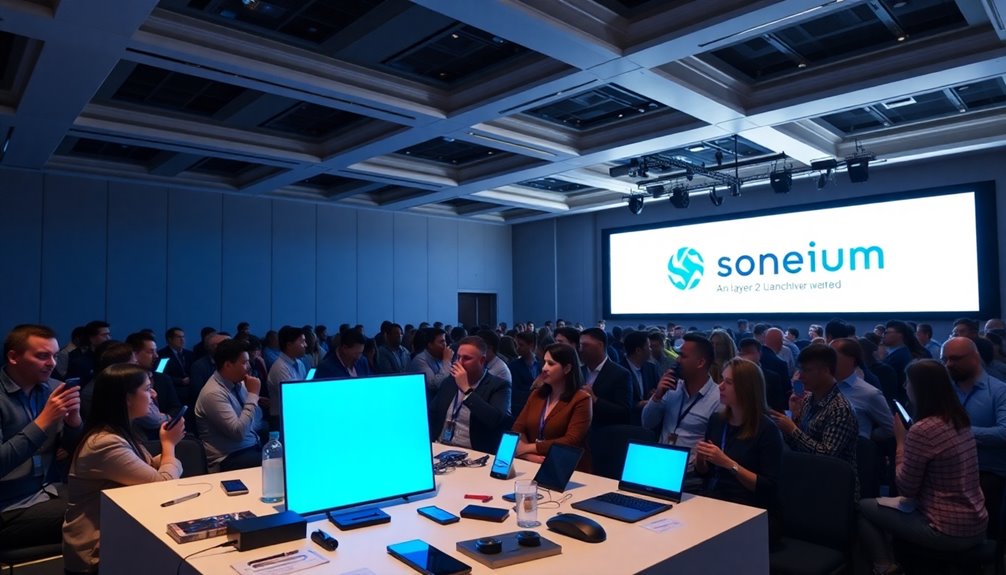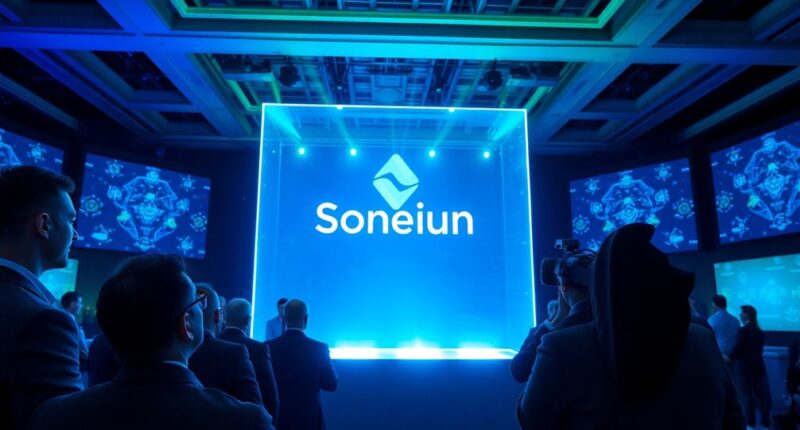Sony's Soneium blockchain launch is a game changer in Layer-2 innovation. By leveraging Ethereum's technology, it ensures smooth compatibility and enhances scalability with the Optimism Foundation's OP Stack. You'll find that it has already handled over 47 million transactions on the Minato testnet, making it a robust solution, particularly for the gaming industry. This move signals Sony's commitment to building a strong Web3 ecosystem alongside partners like Astar Network and Chainlink. Curious about how these advancements might reshape the crypto landscape or what it means for gamers? There's plenty more to uncover about this groundbreaking development.
Soneium's Unique Layer-2 Features

As you explore Soneium's unique layer-2 features, you'll quickly notice its impressive scalability and efficiency.
Built on Ethereum's layer-1 infrastructure, Soneium guarantees EVM compatibility, allowing seamless integration with existing tools and applications.
By leveraging the Optimism Foundation's OP Stack and Superchain technology, it significantly enhances scalability while reducing transaction costs.
The platform processes data off-chain, ensuring lightning-fast transaction speeds, demonstrated by over 47 million transactions on the Minato testnet prior to the mainnet launch. Additionally, Soneium aims to support the gaming industry, focusing on enhancing user experiences in that sector.
With partnerships from industry giants like Astar Network and Chainlink, Soneium boasts a robust ecosystem that supports Web3 innovation, making it a practical solution for developers and users alike.
You'll find Soneium's combination of efficiency and collaboration truly impressive.
Regulatory Scrutiny Intensifies Globally

With governments around the world ramping up their regulatory efforts, the landscape for cryptocurrencies is shifting rapidly. Stricter Know Your Customer (KYC) and Anti-Money Laundering (AML) requirements are being enforced to protect you from fraud and scams.
Crypto exchanges must comply with international standards, ensuring a safer environment. Enhanced transparency measures will reduce the risk of illicit activities, while a more secure regulatory framework is being established for all market participants. Additionally, increased cooperation among countries is aimed at curbing illegal activities in the crypto space.
You'll likely see clearer tax guidelines and simplified structures for reporting crypto earnings. As scrutiny intensifies, stablecoins will face heightened transparency standards, and privacy coins may encounter restrictions or bans.
It's essential to stay informed and adapt to these changes to navigate the evolving regulatory landscape effectively.
Consumer Spending Patterns

Consumer spending patterns reveal significant shifts across various sectors, reflecting changes in priorities and economic conditions.
In 2022, housing expenses accounted for 33.3% of total expenditures, with notable increases in both rented (6.5%) and owned dwellings (8.4%). The rise in housing costs is indicative of the overall trend of increased spending on essentials, as consumers prioritize their basic needs. This trend mirrors the financial considerations for assisted living that many families face as they navigate increasing living expenses.
Transportation costs surged by 12.2%, driven by an 86.9% rise in public transportation spending and a staggering 45.3% jump in fuel prices.
Meanwhile, food expenditures made up 12.9% of total spending, influenced by rising consumer prices.
Although entertainment represented a smaller share at 4.7%, spending on streaming services skyrocketed by 70% since 2021.
These trends illustrate how shifts in consumer priorities adapt to evolving economic landscapes, impacting spending across diverse categories.
Corporate Blockchain Partnerships

While many companies explore innovative strategies to stay competitive, corporate blockchain partnerships have emerged as a powerful tool for enhancing transparency and operational efficiency.
By collaborating with blockchain projects, your company can improve credibility, foster public trust, and enhance brand recognition. This transparency not only boosts public perception but also strengthens customer loyalty and business relationships. Moreover, you gain a competitive edge through improved supply chain visibility. Real-time tracking and smart contracts streamline workflows, reduce costs, and eliminate intermediaries. Additionally, these partnerships enhance trust among partners, making it easier to form and execute agreements.
Government Policy Shaping Blockchain

As governments worldwide recognize the transformative potential of blockchain technology, they've begun to craft policies that not only regulate its use but also encourage innovation.
For instance, the UAE's legislative sandbox allows fintech startups to explore blockchain implications, while Abu Dhabi's FSRA provides guidance on crypto asset regulation.
In the U.S., a hands-off federal approach empowers states like Illinois to create blockchain-friendly legislation.
Identity management is also key; trusted digital identities can drive adoption and ensure compliance across networks. Additionally, the rapid expansion of DLT projects remains a pressing concern, pushing governments to set minimum security standards.
With these policies, governments aim to foster a blockchain ecosystem that's secure, efficient, and conducive to innovation.
Market Adoption Predictions

Market adoption predictions for blockchain technology are increasingly optimistic, fueled by a convergence of regulatory clarity and institutional investment.
You'll see lenient regulations boosting confidence, especially with the approval of Bitcoin ETFs unlocking significant capital. As global jurisdictions advance thoughtful legislation, competition and innovation will flourish.
Moreover, transaction volumes on Ethereum Layer 2s are skyrocketing, driven by the demand for consumer-facing DApps. The launch of Soneium's tokenized music platform allows artists to mint and sell music NFTs directly to fans, showcasing the potential for blockchain in creative industries. As with other investment vehicles like a Gold IRA, understanding the tax implications can enhance financial planning for blockchain assets.
With more crypto companies planning public listings by 2025, the market is poised for significant valuation shifts, potentially eclipsing traditional financial giants.
As these developments unfold, you can expect mainstream finance to integrate more crypto firms, further legitimizing the industry and expanding investor access.
The stage is set for a transformative future in blockchain adoption.
Frequently Asked Questions
How Does Soneium Ensure Security for Its Users?
Soneium ensures security for its users through several key measures. It employs Optimism Rollup technology for data integrity while utilizing a multi-sequencer architecture to decentralize transaction sequencing, reducing risks.
Continuous smart contract auditing and vulnerability scanning actively monitor for potential threats. Plus, centralized control allows for IP protection, enabling swift action against misuse.
What Industries Can Benefit From Soneium's Technology?
Think of Soneium as a bridge connecting various industries to innovative possibilities.
You'll find the entertainment industry thriving with NFTs and digital collectibles, while gaming flourishes through secure in-game assets.
Financial services benefit from decentralized applications and stablecoin integration.
Plus, social platforms can engage users through token rewards.
Each sector harnesses Soneium's blockchain technology, enhancing security, transparency, and user engagement, ultimately creating a more vibrant digital landscape for everyone involved.
Will Soneium Support Other Cryptocurrencies?
Yes, Soneium does support other cryptocurrencies, including Bitcoin, Solana, and Sui, along with over 30 EVM and non-EVM chains.
You'll benefit from its blazing-fast cross-chain transfers, enhancing interoperability across platforms.
While Soneium may require LINK tokens for certain Chainlink services, it's actively working on ongoing integrations to support more cryptocurrencies in the future.
Keep an eye out as their development progresses to see how it can expand your blockchain experience.
How Can Developers Contribute to the Soneium Ecosystem?
You can contribute to the Soneium ecosystem by accessing the Minato testnet to build and test your applications risk-free.
Utilize the full-stack development kit, including gaming SDKs, to create innovative projects.
Joining the Soneium Spark incubator offers mentorship and resources, helping you refine your ideas.
What Are the Potential Risks of Using Soneium?
While Soneium might seem like a shiny new toy, it's important to be aware of the potential risks involved.
You could face security vulnerabilities from both Layer 1 and Layer 2 networks, putting your transactions at risk. These vulnerabilities may arise from various factors, including inadequate encryption, outdated smart contracts, or inconsistencies in protocol governance. Understanding these risks is essential for anyone engaged in cryptocurrency transactions, as they can severely affect asset safety. To better comprehend how these vulnerabilities can emerge, it’s helpful to look into the configuration of different systems, which leads us to the concept of ‘layers of networking explained‘.
Additionally, smart contracts can have hidden flaws, and phishing scams might target you through deceptive links.
Stay vigilant, educate yourself on these threats, and always double-check your links to keep your assets safe.
Conclusion
In launching Soneium, Sony's taken a giant leap, much like Icarus soaring toward the sun. This bold venture into layer-2 innovation not only promises to reshape blockchain dynamics but also challenges the status quo amidst growing regulatory scrutiny. As you navigate this evolving landscape, keep an eye on consumer spending and corporate collaborations—these will be the compass guiding market adoption. With every step, you're part of a transformative journey, potentially penning the next chapter in blockchain history.









